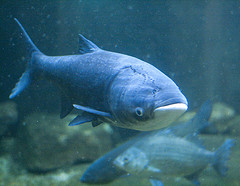
As of today, the Great Lakes are at war.
For almost two decades, states that border the lakes and rely on them for drinking water, recreation, commerce and more have been watching an inexorable invasive force make its way toward their waters.
The feared Asian carp -- a fish growing up to 100 pounds with a voracious appetite that forces out native species wherever it goes -- has been moving steadily up the Mississippi River basin since the 1990s, into the Illinois River and toward the Chicago canal that connects it with Lake Michigan.
The economic and environmental consequences of the carp’s entry into the Great Lakes would be devastating. As Emily Stone explains in OnEarth magazine:
The fear is that the carp will transform the Great Lakes ecosystem into something unrecognizable. One need only look at infested sections of the Illinois River, where federal environmental officials say that carp now comprise nine out of every 10 pounds of living material -- plant or animal -- found in the water. An invasion could devastate the Great Lakes' $7 billion fishing industry and harm the drinking water supply relied on by 40 million people.
Officials have been trying to keep the carp at bay by erecting an electrified fence across the canal and -- earlier this month -- poisoning the water to kill any carp that might have made it past the barricade. Environmental groups including the Natural Resources Defense Council actually supported the poisoning, even though it killed about 200,000 pounds of fish -- only one of which turned out to be an Asian carp.
"No one wants to see that," said Thom Cmar, a Chicago-based attorney with NRDC. But, he added, "The alternative is far worse."
The only solution that anyone sees for now is cutting off the Mississippi River system from the Great Lakes by temporarily closing the canal -- providing “biological separation” of the two ecosystems. The canal has become an important commercial conduit for shipping to the Great Lakes, but environmental groups and the threatened states say they can’t wait any longer for Illinois and the federal government to come up with a solution that ensures the lakes’ safety.
So as of Monday, the state of Michigan is suing Illinois, the Chicago sanitation district and the U.S. government, seeking a preliminary injunction from the U.S. Supreme Court that forces the closing of two navigational locks in the canal that connects the Illinois River and Lake Michigan.
The Michigan attorney general, who filed the suit, compared Asian carp to "nuclear bombs" at a Detroit news conference on Monday. And NRDC's Henry Henderson had this to say in a press statement:
“Throughout this slow-motion disaster we have seen a decided lack of urgency in the actions taken to fend off the carp threat. Hopefully, Michigan’s action will light a fire. Temporary emergency closure of the locks will not fix the problem -- but it will provide breathing room while real, scientifically sound, legally binding solutions are installed and public processes are engaged. This will not be a quick long-term fix."
“The urgent need for action cannot be overstated,” Michigan's request to the Supreme Court states. “Partial measures are no longer an option. … If the Asian carp enter the Great Lakes system, the damage to the environment and economies of the Great Lakes states and Canadian provinces will be staggering with no practical end in sight.”
To understand more about the threat posed to the Great Lakes by Asian carp and what’s being done to stop them, read 'Missile with Fins' Aimed at Great Lakes in OnEarth and see analysis from NRDC experts here on Switchboard.
* * * This post originally appeared on NRDC's Switchboard.
Scott Dodd is the News Editor for OnEarth.org, the website of Natural Resources Defense Council’s award-winning environmental magazine. NRDC is a non-profit organization dedicated to protecting the environment, people and animals. NRDC was founded in 1970 and is comprised of more than 300 lawyers, scientists and policy experts, with more than one million members and e-activists.

